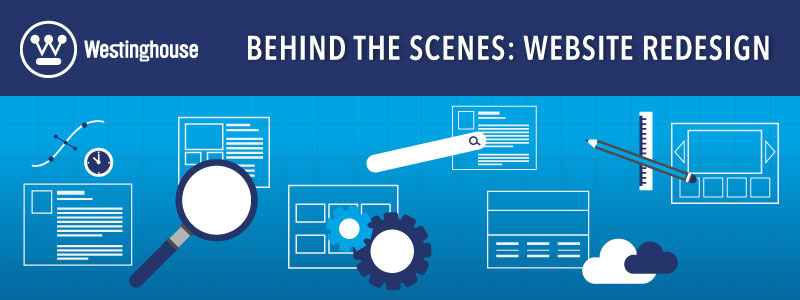
With headquarters in Cranberry Township, Pennsylvania and 12,000 employees globally, Westinghouse Electric Company provides nuclear power plant technology, services and fuel to the commercial nuclear industry. The industry is highly specialized and technical, and that places a high importance on the company’s website as a marketing tool.
The site must tell the Westinghouse story, help utility companies find technical solutions for their plant operations, and communicate the benefits of nuclear energy.
In this post, we’ll take you behind the scenes for a large-scale website redesign project at Westinghouse.
Motivation: Empower Marketers to Manage Site Content

Tom Meston is on the Marketing Communications team at Westinghouse and served as the project lead for the website redesign.
Before the redesign, Westinghouse did not use a Content Management System (CMS). Instead, a centralized group managed the site’s pages, files, images and assets by hand.
For a simple content update, Tom’s group submitted an online request to a centralized service group. Because this group served a number of constituents, it would often take five business days for the request to be completed.
This turnaround time made it challenging for Meston’s team to keep the site up to date. He found it challenging to be agile: to test different scenarios, measure the results and adjust. With multiple days to have a page updated, Meston felt like his hands were tied.
When it came time to embark on a redesign of the Westinghouse site, Meston knew that he needed to select and implement a CMS. Let’s take a further look at how he and his team planned, managed and executed their website redesign.
Step 1: Information Architecture (IA)

Before they looked at technology or systems, HTML or CSS, Meston and team started with a more fundamental exercise: re-designing the
information architecture (IA) of the site.
According to Meston, "Before, the site was based on how we were structured internally as a company, rather than what truly makes sense to our customers. Now, the site is based on a product lifecycle and our customers’ buying cycle, which is much more customer-focused."
Westinghouse selected
Pipitone Group, a Pittsburgh-based Marketing and Communications agency to assist with the planning and implementation of the website redesign.
A team consisting of Meston, Westinghouse communications managers (across different regions and product lines) and Pipitone Group met regularly to collaborate on the new IA.
According to Meston, "We worked with our Marketing organization to ensure the products were structured properly on the site, and our Communications team helped to ensure that our messages were aligned with our corporate strategic objectives."
As you’ll see on
Westinghouse’s website, the team distilled the top-level navigation elements down to five areas:
- About
- Why Nuclear
- New Plants
- Operating Plants
- D&D
Note: D&D stands for "Decontamination and Decommissioning"
These top-level categories make it easy for visitors to determine where to go: prospects go to "About" or "Why Nuclear." Customers go to "New Plants," "Operating Plants" or "D&D." Job seekers go to "About."
The secondary navigation dives deeper into more specific content pages for each category. For instance, the "Why Nuclear" top-level category provides these sections:
- Environment
- Reliability
- Safety
- Jobs
As you’ll see later, the new Information Architecture paid immediate dividends on website traffic: the organization is intuitive to prospects and customers, naturally leading them towards the information they need.
Step 2: Select a Web CMS
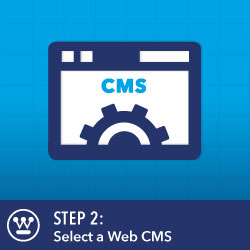
The Westinghouse IT team suggested that Meston use Microsoft SharePoint for the new site’s CMS. The IT Team manages internal SharePoint repositories and holds an enterprise-wide license. As such, the IT Team knew that it could provide the necessary internal support.
When Meston got a look at SharePoint, however, he realized that implementing the site was going to take far more time to develop, cost more, and require internal resources that may not have been available.
He needed a more intuitive tool that could scale out to a growing team of content managers and content editors.
Meston’s team and Pipitone Group looked at a number of options beyond SharePoint, including Drupal and DNN. After a thorough evaluation, they selected our
Evoq Content CMS as the solution that would best suit their needs.
They opted to run Evoq Content via our fully-managed, on-demand offering, freeing Westinghouse’s IT Team from the servers, operating systems, network hardware and physical infrastructure associated with running a website.
"We were finally able to have the agility we needed to be productive and efficient. It was definitely a cause for celebration!”
Because Evoq Content makes it easy for non-technical users to
create and manage content, Meston convinced his IT Team that very little application support was needed (from IT). There was one condition from IT before the project could move forward: Evoq Content and Evoq OnDemand service (our cloud offering) needed to pass an extensive security audit.
Working closely with DNN’s product engineers, the Westinghouse IT team ran security audits and scans on Evoq and we successfully passed all of the tests. But that’s not all: the Westinghouse IT team periodically runs additional security scans, to ensure the Evoq service continues to be secure.
According to Meston, “It was a huge win to have everything firmed up and approved. We were finally able to have the agility we needed to be productive and efficient. It was definitely a cause for celebration!” He looked forward to taking full independence over building and managing the site’s content.
Step 3: Build Reusable Page Templates
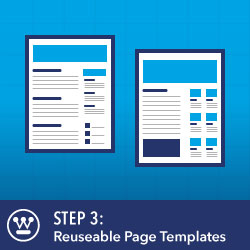
As part of the redesign project, Meston’s team worked with Pipitone Group to design a set of page templates. Composed of HTML and CSS, a page template is a reusable layout. Different sections of a website use different page templates.
On the Westinghouse site, for instance, you’ll notice that the
News page uses a different page template from the Operating Plants page. Pipitone Group presented Meston with wireframes for each of the page templates.
From 5 days down to 5 minutes. That’s a 2,400% improvement in turnaround time for website content updates!
Once they were reviewed and approved by Meston and team, Pipitone’s web developers created the page templates, by transforming the wireframes to functioning HTML and CSS.
As Pipitone Group developed the templates, Meston worked in parallel to round up content from across the organization. According to Meston, "I wrote some of the site’s new content, while others wrote sections that were specific to their business units. It was a long process, but well worth it in the end."
Once the page templates were completed and available in Evoq Content, Meston and team began to populate the functioning web pages. Having direct access to the website was a bit new to Meston: "It was really nice to be able to easily add and edit content on my own terms. It sped up the process significantly. Before, it could be days before information was updated. Now, I can do it myself in a matter of minutes."
From 5 days down to 5 minutes. That’s a 2,400% improvement in turnaround time for website content updates!

Pictured: The Sanmen Unit 1 CA03 Module Vertical Lift (source: the
Westinghouse website)
As you browse the Westinghouse site, you’ll notice frequent use of visually stimulating images that are over 1,000 pixels wide.
Meston worked closely with a staff photographer to source many of these photos. Other images were acquired from various projects, while colleagues in Europe and other operations in the U.S. contributed some more.
Meston gave CMS access to some of his graphic design colleagues, who used Evoq Content to populate pages with photos, images, text, and more than five hundred product sheets.
Step 4: Implement Mobile Responsive Design across the Site
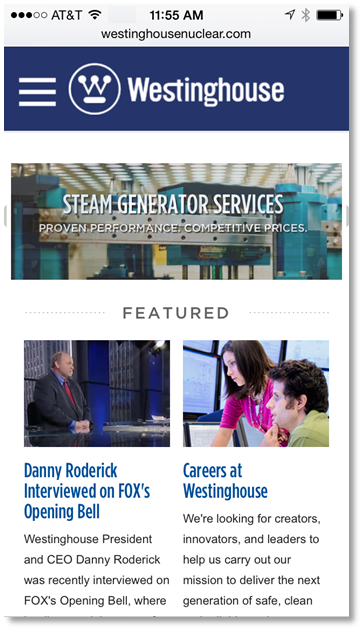
Pictured: The Westinghouse homepage, as viewed from my smartphone.
"Having responsive design is an absolute must."
The website redesign project was the perfect time to make the entire Westinghouse site mobile-friendly. The approach Meston and Pipitone Group took was to implement
Responsive Web Design across all pages.
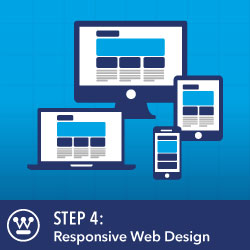
Responsive design utilizes HTML and CSS media queries to adjust the rendering of page elements to the dimensions of the viewing device (e.g. desktop, tablet or smartphone). For example, when viewed on a desktop, the site would render using the full width of the screen.
On a smartphone, however, page elements need to be stacked in a more vertical orientation. Pipitone handled all of the necessary coding to implement responsive design across all pages.
On the re-designed site, over 20% of traffic today is coming from mobile devices. Meston expects that this percentage will grow significantly over time. In fact, if responsive design had not been implemented, this percentage would be far lower. According to Meston, "Having responsive design is an absolute must. To my knowledge, none of our competitors have responsive websites, so this puts us at a distinct competitive advantage."
Step 5: Prepare Content and Processes for Regionalized (In-Country) Sites

As if Meston and team didn’t already have enough to do, “we’re now building local sites for the countries where we have major operations.” Westinghouse will also soon have the website available in seven additional languages beyond English.
As he prepares for the new sites to have content populated, Meston will provide 5-6 users access to Evoq Content, so that they can create and edit content in their native language.
When expanding usage to these in-country content managers, Meston will consider using our
Workflow feature, which enables him to review and approve content updates before they go live to the site.
Imagine expanding site operations during the "pre CMS" days. Meston would need to review site updates submitted by in-country content managers. He’d probably go back and forth via email for needed changes. Then, a request would be submitted to the internal service group. A few days later, the update would be made on the site.
Today, this entire process happens in Evoq: Meston and the in-country content managers are empowered to make their own updates. And Meston can use workflow to instrument a layer of quality control. It’s quick and it’s seamless.
Step 6: Add Fuel to the Content Marketing Engine

Launching a captivating and re-designed website is a good step, but more is needed. Westinghouse, like all brands, needs to create, share and curate content that attracts and interests their target audience. They need to fuel the content marketing engine.
For two examples where the engine needs to be regularly fueled, check out the
Features and Blog sections of the site. The Features area highlights recent news, such as CEO Danny Roderick appearing on FOX's Opening Bell.
The Westinghouse Blog, which was launched as part of the website redesign, includes thought leadership content and other topics of interest.
According to Meston, "With Evoq Content’s newfound ease of publishing content comes the challenge of keeping the content machine well-fed. That’s something we’re working on as a global communications organization to improve and refine."
Meston notes that the site’s new information architecture is drawing more page views to the products and services offered by Westinghouse. The new IA, combined with frequent blog posts and features, helps provide more content to be shared across Westinghouse’s social media channels.
Frequent content publishing and social sharing requires more formal processes for communicating across the organization. According to Meston, "We’ve improved collaboration across our social media, web, marketing communications and public relations functions. And that’s all been driven by our redesigned website."
Wrapping Up
The Westinghouse website is an important business driver for the organization: it attracts new customers, while providing key information to existing customers. The Evoq Content CMS empowered Westinghouse to independently manage site content, while scaling the content team globally.
In addition, the ease of publishing enabled Meston and team to develop and sustain a content marketing engine, to provide useful information to Westinghouse’s target audience. Turnaround time is down, while published content and website traffic is up. Things are moving in the right direction.
Related Reading
Want more insights and tips on website redesign? Brad Shorr from web design firm Straight North recently published a post, “9 Overlooked Elements of a Website Redesign (and How to Do It Right).”